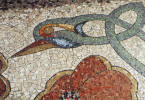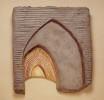|
Sunday, July 5, 1998
The New York Times
Two
Shows: Frescoes and Landscapes
By VIVIEN RAYNOR
PIERMONT
|
|
|
UNLIKE the Grim Reaper, the Great Gentrifier is
selective about his victims, picking towns with signs of a prosperous past
that can be converted into tourist attractions. One example is this pretty
hamlet with a waterfront that, once a port of call for sidewheelers and
cargo boats working the Hudson River, is now ye olde mini‑mall, complete
with storefront galleries exhibiting contemporary art. Gentrification's
incongruities are mild when compared with those perpetrated by the
founding Surrealists but they are nonetheless significant for showing how
the philosophy of the irrational, once cause for outrage, has become a
part of daily life.
Conspicuous in this enclave
of corporate cleanliness are the Piermont Flywheel and Allen Sheppard
Galleries, each a white space with lighting strong enough to permit
microsurgery.
|
| The show in the first gallery, an artists' cooperative, is
by Adele Myers, a nun at the Dominican convent in Sparkill who, with the
sculptor David Weinrib, presided over its gallery, Thorpe Intermedia,
until its demise in the early 1990's. A teacher of art at St. Thomas
Aquinas College nearby, Sister Adele has produced ‑ but not yet installed
‑ a mosaic mural for Thorpe Village, the convent's housing project for the
elderly. |
 |
| As an artist, however, Sister Adele is
something of a contradiction because she paints abstractions in the
ancient medium of fresco on cement, which was discovered by the Romans but
has since acquired industrial connotations. Her method is to model small
to‑medium‑size reliefs, adding fresco selectively so that the result is
not painted sculpture but rather sculpture enhanced by color (including
the gray of the cement) and, like all balancing acts, it requires a sharp
eye, agile mind and perfect timing. |
|
Besides living up to its title, "Earth Dance/ River
Dance" demonstrates all those qualities being an arrangement of two
shimmering ribbons, shading from blue‑green to white and back. Entwined,
the ribbons meander across an unpainted ground but not without
interruption since the ground is divided into five slabs of equal size.

|
| Different in character but no less successful are "Jesse"
and "Sanctuary." The first is a slab of cement pierced with leaf‑shaped
holes and laid like a stencil over a painting of leaves; the second is the
modeled and painted image of a passage receding into the distance under
Gothic arches ‑ a rare example of illusionism. |
  |
|
Sister Adele also includes
small organic abstractions arranged in a vertical group, many of them
barely touched with color, as well as one of her pancake‑like reliefs ‑‑
this in pale yellow turning green at the edges. Though full of high
points, the show has a few uncertain moments. like the busy modeling in
the unpainted reliefs and the artist's occasional use of acrylic paint.
But the chief problem is a strung‑out installation combined with clinical
lighting. Where is it written that the very pores in a work of art trust
he instantly visible? The show closes next Sunday. |
